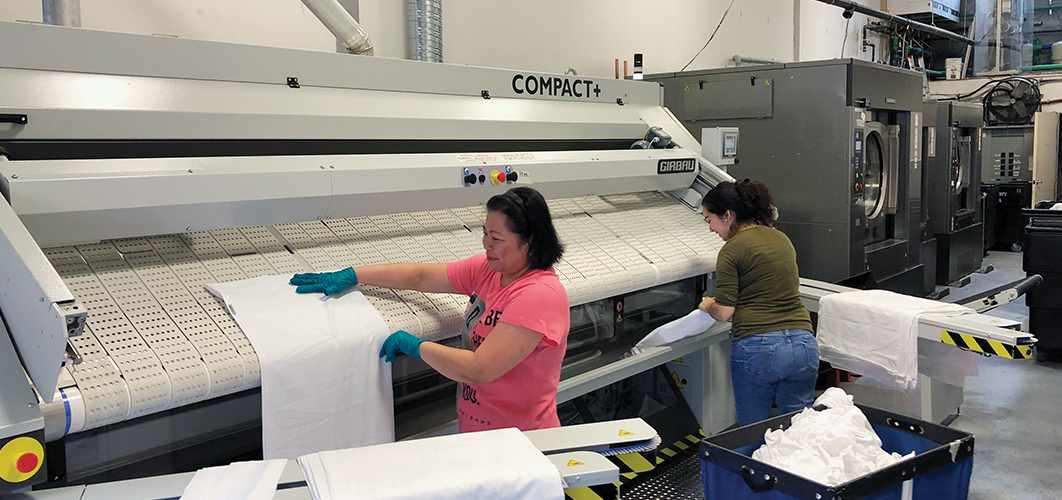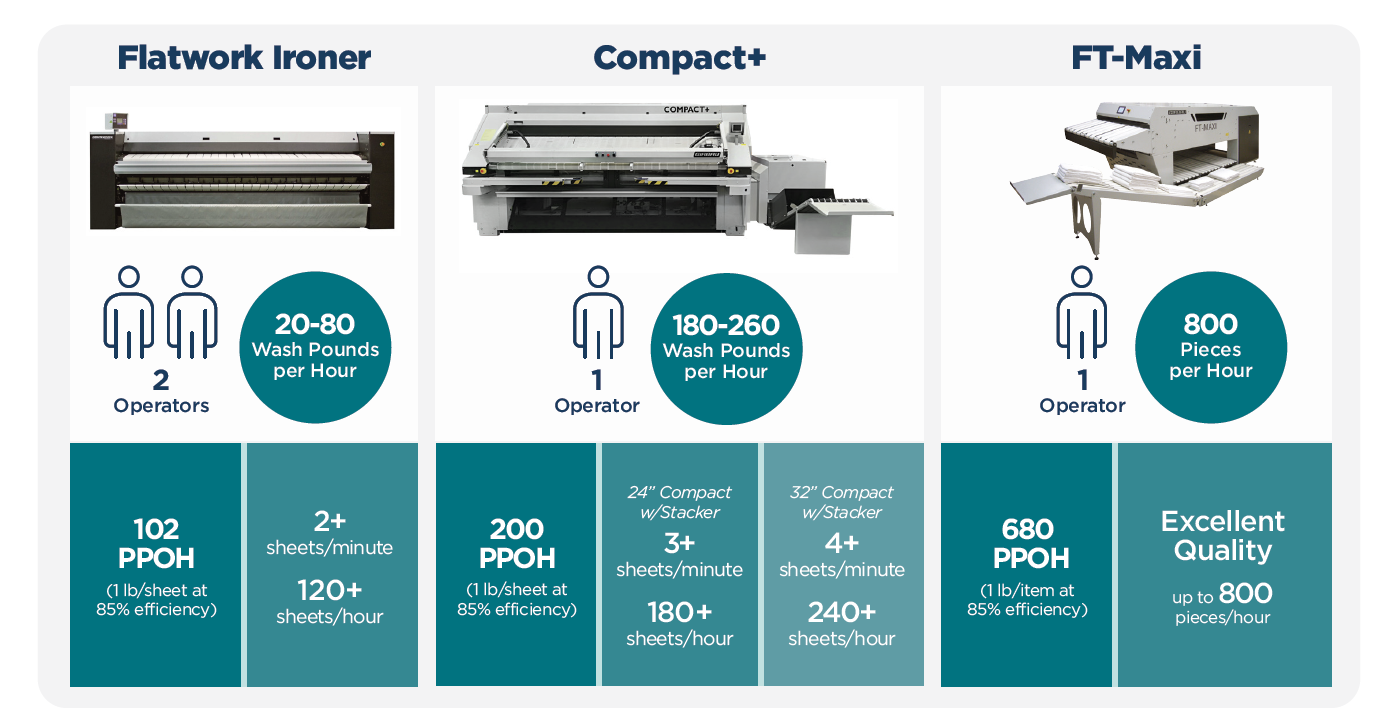Starting from scratch, Whistler Laundry Inc., in Whistler, BC., stepped into laundry automation a little at a time. The commercial laundry started with three washers and three dryers. It quickly added more washing and drying capacity, along with a heated-roll ironer and integrated folder. Production, quality and profits escalated.
“That first ironer improved production and revenue 30 percent,” said co-owner Steve Wheeler. By the end of year four, the laundry had invested in an all-in-one feeder/ironer/folder/stacker/accumulator — boosting production and quality by another 30 percent.
“We’ve grown way quicker than we expected,” added Wheeler. “We’re getting close to a production threshold again as we are very, very busy. The next logical step in automation might be a tunnel washing system so we can serve even larger hotels.”
In this example, Whistler Laundry started small and stepped into automation when the time was right. I’ve seen this again and again throughout my career. So, yes, even smaller commercial and on-premise laundries can benefit by introducing automated machinery.
When it comes to taking the leap into automation, investing in one piece of equipment can significantly impact quality, production and per pound laundry processing costs. If you’re at a crossroads and considering automation, remember that you aren’t alone in determining whether it makes sense. Contact your equipment distributor to help you assess — in hard numbers — if and when the time is right.
In this column, I’ll provide some insight into how to get the most out of your laundry as you move into automation. The first step is to ensure an efficient and productive wash/dry process.
Washer & Dryers
A solid wash/dry process is key to lower processing costs. Critical to a laundry’s wash line are washers and dryers sized to meet your production goals. For optimum productivity and efficiency choose washers offering a soft-mount industrial design, high-G-force extract, excellent efficiency, flexible programmability, automatic chemical injection and options for auxiliary heat and steam, ozone and reclamation systems. Similarly, select efficient partner dryers with phased programmability, automatic reversing and moisture sensing. Here’s why:
1) Soft-Mount Design Freestanding washers make for simple, less-costly installation, without bolt-down, and allow for close installation clearances of less than a half inch. By comparison, hard-mount equipment requires reinforced concrete foundations, bolt-down and clearances of up to 18 inches or more. Soft-mount machines installed right next to each other provide for increased wash production per square foot and improved workflow.
2) High G-Force In general, soft-mount washers generate higher G-Force extract than hard-mount washers. Or, if hard-mount washers do hit high-speed extract, it’s only for a short duration at the end of the spin cycle. That’s why a soft-mount washer generally removes more moisture during extract — reducing dry time by up to 50 percent. This catapults productivity. Look for washers producing 350-400+ G-force.
3) Flexibility A flexible control is vital to laundering a variety of items. Washers should offer programmability of automatic chemical injection and control over G-force, rotation action, number of baths and rinses, water temperature, cycle times and water levels. Also critical are auxiliary heat and steam options as these are necessary to remove stains from many hospitality and food and beverage items. On the dryer side, seek phased programmability, efficient, affordable heat sources and control over rotation action, automatic reversing and moisture sensing in order to reduce wrinkling and over-drying.
4) Efficiency Choose efficient machines that reduce the consumption of utilities and their associated costs. It’s important to realize that high G-force washers will shorten dry time, resulting in less natural gas consumption by the dryer — cutting utility costs.
5) Compact Footprint Choose washers and dryers that feature bigger basket capacities, yet smaller footprints. There are models on the market that output considerably more production, using less labor and energy when compared with other options occupying a larger area.
Adding a Flatwork Ironer
If your laundry wants to offer a higher quality finished product, it might be time to add an ironer. A basic ironer provides a high-quality finish that improves the look and feel of bed sheets, linens and tablecloths. Additionally, most ironers offer an integrated folder that performs primary folds on king or queen sheets after they are ironed. Thus, operators only perform cross-folds and stack. There is a significant, visible difference between pressed and non-pressed sheets. If your commercial laundry serves the hospitality industry, you’ll provide a better-finished product and likely open the doors to new business and larger accounts. Meanwhile, your laundry will catapult productivity and lower dryer usage and costs because items move straight from the washer through the ironer. Thanks to less dryer wear and tear, linens should also last longer.
A basic flatwork ironer is able to iron over 120 sheets per hour using two operators.
Adding an All-In-One Feeder, Ironer, Folder, Stacker & Accumulator
When a laundry process between 180 and 260 washing pounds per hour, it might be time for an all-in-one that automatically irons, folds and stacks. An all-in-one eliminates almost all hands-on flatwork folding and stacking. Using a basic flatwork ironer, operators must feed, catch and perform the cross folds. With a higher-production, all-in-one machine, operators feed sheets. The primary folding, cross folding and stacking are all automatically performed for boosted quality and production.
An all-in-one machine will process (iron, fold and stack) over 240 sheets per hour using one operator, and 180 to over 240 sheets per hour with a single operator. Additionally, to further boost quality and production, some offer optional spreader/feeders.
Adding a Towel Folder
The most compelling reasons to move from hand folding to an automatic folder is improved production, enhanced quality and labor efficiencies. Laundries processing 250-500+ laundry pounds per hour should consider adding a basic towel folder. Generally, a typical laundry operator can sort, fold and stack different-sized towels at a rate of 120 pieces per hour. By adding a basic automatic towel folder, a laundry can fold and stack at least 800 different-sized pieces per hour, with just one operator.
If you are looking to further automation, it makes sense to add a more advanced, auto-sort towel folder. These machines automatically sort, fold and stack up to 800 pieces per hour, with just one operator. Through automation, and the installation of an auto-sort folder, laundries can cut labor hours by 87 percent. If you do the math on 120 hand folded towels versus 600-800 machine folded towels per hour, the savings is more than eight labor hours per day!
With the addition of a basic or auto-sort folder, laundries will enhance quality through the creation of consistent folds and stacks. This simplifies prepping laundry for transportation and storage, which saves additional labor hours and further improves facility productivity.
In the end, small and large laundries alike should want to heighten efficiency, maximize productivity, enhance quality and reducing labor. In doing so, they cut processing costs and boost profits.


